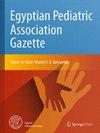A prospective cohort study of severe sepsis-induced dyslipidemia and changes in D-dimer levels in children: do they affect the prognosis?
IF 0.5
Q4 PEDIATRICS
引用次数: 0
Abstract
The dyslipidemia and changes in D-dimer values that occur in children with severe sepsis remain unidentified. The current research aimed to explore the relationship between D-dimer and lipid profile values, including total cholesterol (TC), lipoproteins, apolipoprotein A-V (Apo A-5), triglycerides (TG), and in-hospital nonsurvival in children with severe sepsis or septic shock in pediatric intensive care. The study design is as follows: prospective cohort study. Children with severe sepsis or septic shock who were admitted to the intensive care unit of a university pediatric hospital. Vital signs, sepsis assessment, pediatric sequential organ failure assessment (PSOFA) score, high-density lipoprotein (HDL), Apo A-5, TG, low-density lipoprotein (LDL), TC, D-dimer, mortality outcome, and pediatric risk of mortality (PRISM) III score were evaluated. The primary outcome was in-hospital nonsurvival. The nonsurvivors had significantly higher D-dimer levels than the survivors, with a significant cutoff level of 0.87 μg/mL (AUC: 0.85, sensitivity: 93.3%, PVN: 90.6%, accuracy: 79.0%, PVP: 72.5%, and specificity: 64.7%). D-dimer was inversely correlated with WBC count and positively correlated with patient age, PRISM III score, PSOFA score, and INR. However, nonsurvivors had higher TG levels and lower TC, HDL, LDL, and Apo A-5 levels than survivors, but this variation was insignificant. Apo A-5 levels were inversely correlated with HDL and positively correlated with TG levels. This study suggests that D-dimer is a promising biomarker for severe sepsis in children, with a mortality cutoff level of 0.87 μg/mL. However, lipid profiles are not predictors of sepsis-related mortality.严重脓毒症诱发儿童血脂异常和 D-二聚体水平变化的前瞻性队列研究:它们会影响预后吗?
严重脓毒症患儿的血脂异常和D-二聚体值的变化仍未确定。目前的研究旨在探讨儿科重症监护中严重脓毒症或脓毒性休克患儿的D-二聚体和血脂谱值(包括总胆固醇(TC)、脂蛋白、载脂蛋白A-V(载脂蛋白A-5)、甘油三酯(TG))与院内非存活率之间的关系。研究设计如下:前瞻性队列研究。入住某大学儿科医院重症监护室的重症脓毒症或脓毒性休克患儿。对生命体征、脓毒症评估、儿科序贯器官衰竭评估(PSOFA)评分、高密度脂蛋白(HDL)、载脂蛋白A-5、总胆固醇(TG)、低密度脂蛋白(LDL)、总胆固醇(TC)、二聚体(D-dimer)、死亡结果和儿科死亡风险(PRISM)III评分进行了评估。主要结果是院内非存活。非存活者的 D-二聚体水平明显高于存活者,显著的临界水平为 0.87 μg/mL(AUC:0.85,灵敏度:93.3%,PVN:90.6%,准确度:79.0%,PVP:72.5%,特异性:64.7%)。D 二聚体与白细胞计数成反比,与患者年龄、PRISM III 评分、PSOFA 评分和 INR 成正比。然而,与幸存者相比,非幸存者的 TG 水平较高,TC、HDL、LDL 和载脂蛋白 A-5 水平较低,但这种差异并不显著。载脂蛋白 A-5 水平与高密度脂蛋白成反比,与谷固醇水平成正比。这项研究表明,D-二聚体是儿童严重败血症的一种有希望的生物标志物,其死亡率临界值为 0.87 μg/mL。然而,血脂谱并不能预测与败血症相关的死亡率。
本文章由计算机程序翻译,如有差异,请以英文原文为准。
求助全文
约1分钟内获得全文
求助全文
来源期刊

Egyptian Pediatric Association Gazette
PEDIATRICS-
自引率
0.00%
发文量
32
审稿时长
9 weeks
期刊介绍:
The Gazette is the official journal of the Egyptian Pediatric Association. The main purpose of the Gazette is to provide a place for the publication of high-quality papers documenting recent advances and new developments in both pediatrics and pediatric surgery in clinical and experimental settings. An equally important purpose of the Gazette is to publish local and regional issues related to children and child care. The Gazette welcomes original papers, review articles, case reports and short communications as well as short technical reports. Papers submitted to the Gazette are peer-reviewed by a large review board. The Gazette also offers CME quizzes, credits for which can be claimed from either the EPA website or the EPA headquarters. Fields of interest: all aspects of pediatrics, pediatric surgery, child health and child care. The Gazette complies with the Uniform Requirements for Manuscripts submitted to biomedical journals as recommended by the International Committee of Medical Journal Editors (ICMJE).
 求助内容:
求助内容: 应助结果提醒方式:
应助结果提醒方式:


